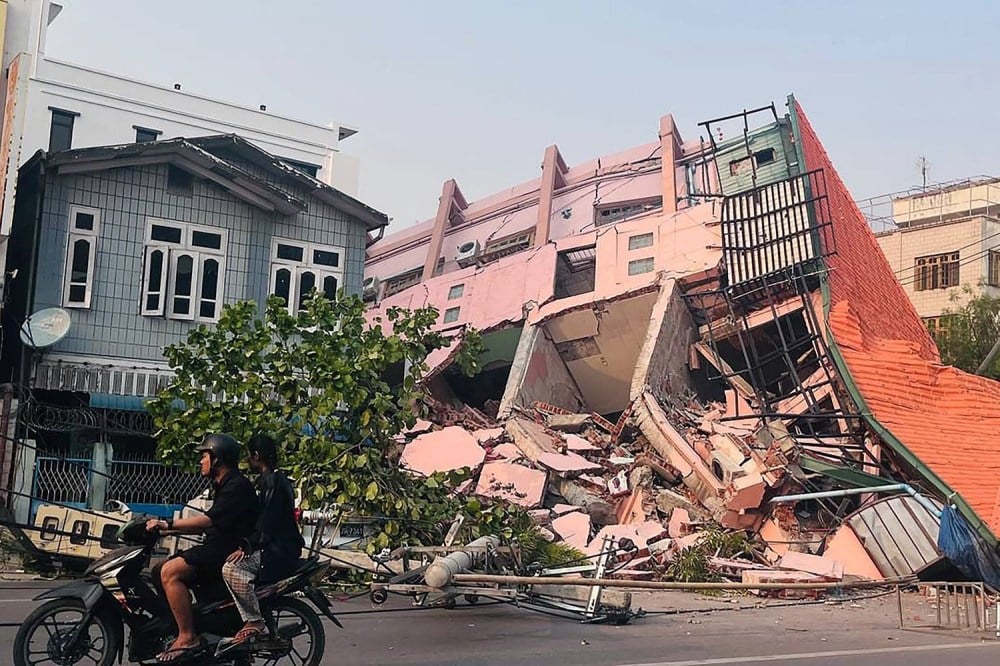
Shattered Ground: Myanmar’s 7.7 Magnitude Earthquake Leaves Southeast Asia Reeling
On March 28, 2025, at approximately 8:22 AM local time, a catastrophic 7.7 magnitude earthquake rocked central Myanmar, unleashing a wave of destruction that has reverberated across Southeast Asia. With its epicenter located just 28 kilometers (17 miles) northeast of Mandalay—Myanmar’s cultural heart and second-largest city—the shallow quake struck at a depth of only 10 kilometers (6.2 miles), magnifying its destructive force. Buildings collapsed, lives were lost, and an entire region was left grappling with the aftermath of one of the most powerful seismic events in over a century. As of March 30, 2025, the death toll continues to climb, rescue operations persist, and the world watches in horror and solidarity.
A Quake of Unprecedented Force
The United States Geological Survey (USGS) recorded the earthquake’s magnitude at 7.7, with its energy release likened to "more than 300 atomic bombs" detonating simultaneously. Occurring along the Sagaing Fault—a major strike-slip fault running north-south through Myanmar—this shallow quake caused violent shaking that flattened homes, ancient pagodas, and modern infrastructure alike. In Mandalay, a city of over 1.5 million people, iconic landmarks like the Mahamuni Pagoda suffered severe damage, while residential areas were reduced to rubble.
The tremors didn’t stop at Myanmar’s borders. They rippled across Southeast Asia, shaking cities and towns hundreds of miles away. In Bangkok, Thailand—1,300 kilometers (800 miles) from the epicenter—residents reported swaying buildings, and a 30-story skyscraper under construction collapsed, killing at least 17 workers and leaving 83 others unaccounted for. Further north, in Yunnan Province, China, 600 miles from the epicenter, people fled into the streets as the ground trembled. The USGS issued a "red alert," forecasting "significant casualties and economic losses," a grim prophecy already unfolding.
The Human Toll: Myanmar and Beyond
As of Sunday, March 30, Myanmar’s military government reported a staggering death toll of 1,644, with 3,421 injured and 139 people still missing. These figures, however, are preliminary, as rescuers continue to sift through debris in Mandalay, Naypyidaw, and rural villages along the fault line. In Mandalay alone, a woman was pulled alive from a collapsed apartment building after 30 hours, her rescue a rare moment of hope amid widespread despair. Local hospitals, already strained by years of conflict and underfunding, are overwhelmed, with reports of patients being treated in parking lots due to damaged facilities.
In Thailand, the collapse of the Bangkok skyscraper has turned the city into a disaster zone. Rescue teams, equipped with drones, robots, and heavy machinery, are working around the clock to locate survivors. Thai authorities have confirmed 17 deaths, but with dozens still trapped, the toll is expected to rise. Prime Minister Paetongtarn Shinawatra declared a state of emergency in the capital, urging citizens to remain vigilant as aftershocks continue.
The quake’s reach extended to Bangladesh, where tremors triggered landslides in Chittagong, and to eastern India, where minor structural damage was reported in Kolkata. While these areas avoided the worst, the event underscores the interconnected seismic risks facing the region.
Aftershocks and Escalating Chaos
The initial quake was only the beginning. Minutes later, a 6.7 magnitude aftershock struck, followed by dozens of smaller tremors, including a 5.1 magnitude quake near Mandalay on March 30. These aftershocks have destabilized already weakened structures, complicating rescue efforts and terrifying survivors camped in open fields to avoid collapsing buildings. Seismologists warn that aftershocks could persist for weeks, posing an ongoing threat to a region struggling to regain its footing.
In Myanmar, the disaster has collided with an existing humanitarian crisis. The country’s civil war, pitting the military junta against ethnic armed groups and the shadow National Unity Government (NUG), has displaced millions and crippled infrastructure. On March 30, the NUG and its People’s Defence Force (PDF) announced a two-week ceasefire in quake-affected areas, halting offensive operations to focus on relief. However, reports from Sagaing Region indicate the junta has continued airstrikes on rebel-held zones, killing at least 12 civilians since the quake. UN Secretary-General António Guterres condemned the attacks, calling them “an unconscionable act” during a time of national mourning.
A Region’s Resilience Tested
Myanmar’s challenges are compounded by its geography and socio-political state. The Sagaing Fault, responsible for this quake, has a history of seismic activity—most notably the 1912 Taunggyi earthquake, which registered a similar magnitude. Yet, modern building codes and disaster preparedness have lagged, particularly in rural areas where mud-brick homes offer little resistance. In Mandalay, volunteers armed with shovels and bare hands dig alongside professional rescuers, their efforts hampered by severed roads and a lack of heavy equipment.
Thailand, meanwhile, faces a different reckoning. Bangkok’s rapid urbanization has led to a proliferation of high-rises, but enforcement of seismic standards remains inconsistent. The collapse of the under-construction tower has sparked outrage and calls for stricter regulations, even as the city mourns its losses.
Global Response: Aid and Obstacles
The international community has mobilized to assist. India’s Operation Brahma delivered 137 tonnes of food, water, and medical supplies to Yangon on March 29, while the European Union pledged €2.5 million ($2.7 million) in emergency aid. South Korea sent a 50-member rescue team, and Malaysia and Singapore have contributed financial and logistical support. The UN’s Office for the Coordination of Humanitarian Affairs (OCHA) is coordinating efforts but warns of dire shortages: trauma kits, blood bags, anesthetics, and antibiotics are critically needed, yet Myanmar’s junta has restricted access to some rebel-held areas, delaying deliveries.
Aid agencies also face logistical nightmares. Damaged airports, flooded roads from seasonal rains, and ongoing conflict have slowed the flow of help. The World Health Organization (WHO) estimates that over 2 million people may require assistance in Myanmar alone, a figure that could strain global resources already stretched by other crises.
What Lies Ahead
This earthquake—the strongest to hit Myanmar since 1912—has exposed vulnerabilities that will take years to address. For Myanmar, recovery means rebuilding not just homes but a fractured society. For Thailand, it’s a wake-up call to bolster urban resilience. Across Southeast Asia, the event highlights the urgent need for regional cooperation on disaster preparedness, as tectonic forces show no regard for borders.
As of March 30, 2025, the focus remains on the immediate: saving lives, providing shelter, and mourning the lost. Stories of courage emerge daily—a teacher in Mandalay who shielded students from falling debris, a Bangkok firefighter who worked 48 hours straight—but so do tales of grief. The road to recovery will be long, but it begins with the world’s response today.
How You Can Help
If you’re moved to act, consider supporting reputable organizations like the Red Cross, Médecins Sans Frontières (Doctors Without Borders), or local Southeast Asian relief funds. Sharing verified information can also amplify the voices of those in need. In a disaster of this magnitude, every gesture of support matters.

Can AI Block You on Twitter? Understanding AI-Powered Moderation
Explore how artificial intelligence is used on Twitter for content moderation, account restrictions,...

The Gorakhpur Tragedy, August 2017 — A Dark Chapter in India's Healthcare
In August 2017, India woke up to one of the most heartbreaking and shocking news headlines — over ...
The 2008 IBN7 Cash for Vote Sting Operation — Exposing the Dark Side of Indian Politics
The 2008 IBN7 Cash for Vote Sting Operation — Exposing the Dark Side of Indian Politics

